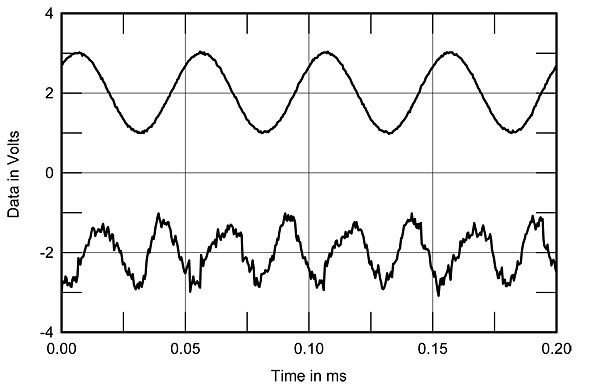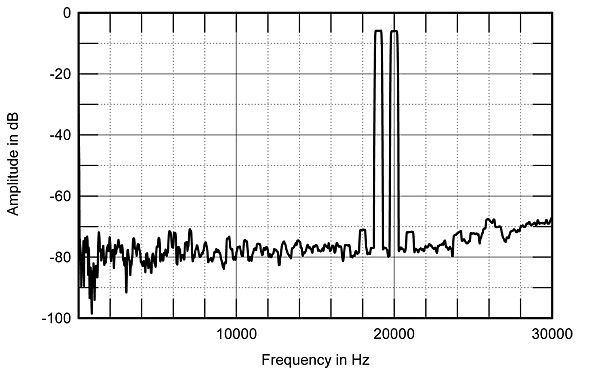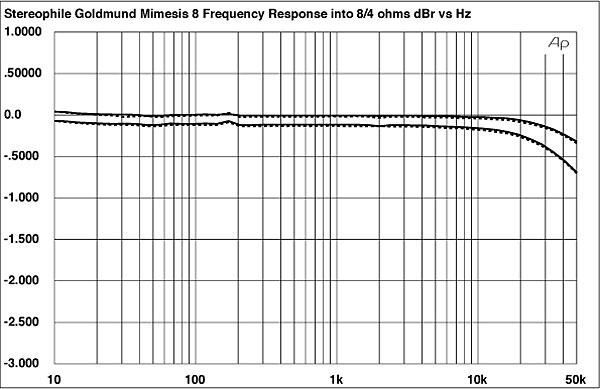| Columns Retired Columns & Blogs |
Great article John.
It's no wonder that you always hear people saying, " Goldmund gear is amazing, but it's very component dependent". The stuff works best with each other, which could be uber pricey to say the least.
The Goldmund's rated power specification leaves me a bit puzzled, as it is an unusual, current-limited amplifier that delivers the same output power into 2, 4, and 8 ohms. That this is not true of the Mimesis 8 is shown by fig.1, which plots the distortion and noise against output power for a 1kHz signal into 8, 4, and 2 ohm loads with one channel driven. The 1% distortion point was reached at 185W into 8 ohms (22.7dBW), 260W into 4 ohms (21.1dBW), and 305W into 2 ohms (18.8dBW), revealing rather a higher power-supply impedance than the Levinson No.23.5. With both channels driven, the 8 and 4 ohm power dropped to 170W and 245W, respectively, while the wall voltage dropped to 110V for the 2-ohm/one-channel and 4-ohm/two-channel tests. While not the equal of the Mark Levinson or Krell amplifiers when it comes to voltage source behavior, the Mimesis 8 gives out more power than its specification would imply. (The maximum 8 ohm power of 185W is equivalent to 54.4V peak, well above the specified maximum voltage swing.)

Fig.2 shows the manner in which the THD and residual noise change with signal frequency, again into 8, 4, and 2 ohms. The two channels are somewhat different in their behaviors: the left channel can be seen to be a little more linear than the right below 2kHz, into 8 and 4 ohm loads; the right channel, however, has less of a rise in ultrasonic distortion products. The left channel only is shown into 2 ohms; the amplifier is less happy than the Mark Levinson No.23.5 with extremely low loads. These tests were done after the one-hour preconditioning period, during which the distortion dropped to about half of what it was when the amplifier was cold. (The heatsink was far too hot to touch at the end of this time.) Repeating the tests with the amplifier's heatsinks at a somewhat lower temperature gave a slightly different result, implying that the Mimesis 8's nature will be rather signal-history–dependent.

As well as there being more distortion in the top audio band than below it, the nature of that distortion was different also. At very low frequencies, the predominant distortion was third-harmonic, as can be seen from fig.3, which shows the spectrum for a 50Hz tone at 72W into 4 ohms. This was at a minuscule –75dB (0.02%) level, however, while even lower amounts of fifth (250Hz), sixth (300Hz), and eighth (400Hz) can be seen. Note the absence of power-supply–related components, despite the relatively small size of the output stage reservoir caps. In the midband, the distortion becomes more complex, though it remains at a very low level. The lower trace in fig.4 shows the THD waveform with the 1kHz fundamental notched out (equaling 0.007%) at a 100W into 8 ohms level, while that in fig.5 shows the distortion waveform for a 20kHz waveform at 1W into 8 ohms. (The amplifier's protection circuitry cut off the output at levels much higher than that.)



The trend of the changes shown from fig.3 through fig.5 is to replace what is predominantly third-harmonic with second-harmonic as the frequency rises. I have no idea what the subjective consequences of this are, but it is interesting that the amplifier's fundamental behavior seems related to the signal's spectral content, as well as its history, and the load impedance.
This dependency also applied in a small way to the output impedance: assessing this by measuring the voltage drop at a 1W level when an open-circuit load was replaced by an 8 ohm resistor gave a figure of 0.04 ohms at 20Hz and 1kHz. Repeating the measurement using a 4 ohm load, thus demanding twice as much current, gave a figure twice this, at 0.08 ohms. Though this is still inconsequential, it puzzles me, as does the fact that at 20kHz, the discrepancy was smaller, at 0.12 ohms (8 ohm load) vs 0.15 ohms (4 ohm load).
Looking at the spectrum of products produced when the amplifier reproduces an equal mix of 19 and 20kHz tones (fig.6) reveals excellent behavior. Note, however, that this was performed at a lower output level than usual, 20V p-p rather than 48V, into 4 ohms. This was due to the fact that the Mimesis 8's protection circuit cut off the output above this level.

The Mimesis 8 was the quietest amplifier I have experienced. Referred to a nominal 1W into 8 ohms, the audio-band noise—unweighted, 22Hz–22kHz—lay 112/109dB (L/R) down. To give an idea of what this means, when the amplifier is cruising with an output of 10V, the noise added by the amplifier is just one millionth of that figure, at 10µV. Given the fact that Goldmund's own loudspeakers are extremely sensitive, this low noise was probably an essential design goal. Both the 10kHz squarewave (fig.7) and the small-signal frequency response (fig.8) revealed a reasonably wide-band nature, the bass being flat to infrasonic frequencies and the treble being a negligible –0.05dB at 20kHz. This, however, was into 8 ohms. Into 4 ohms, the output dropped to –0.2dB at 20kHz, this again indicating some interdependency between the amplifier's intrinsic behavior and the external conditions. Though not shown, the response with the amplifier hooked up to the Wilson WATTs measured –0.5dB at 20kHz. Correlating with this evidence that the HF response was not as unlimited as the specification would imply, the risetime, judging from the 10kHz squarewave shown in fig.7, was significantly higher than expected at 4.4µs vs 0.7µs.


Channel separation is specified as being greater than 100dB. I could only get near this figure by plugging a shorted RCA plug into the undriven input. With the amplifier connected as for conventional use, with both channels' inputs connected to the Audio Precision's outputs, the crosstalk turned out to be much higher than I would have liked, lying just below –40dB across the band. This was confirmed in the listening room, a clean version of the music being audible from the undriven channel's loudspeaker with the driven channel hooked up to a dummy load. Though –40dB is probably just too low in absolute terms to affect image width—I failed to note any image narrowing with music signals—it is still somewhat alarming.
The Mimesis 8's voltage gain when loaded with 8 ohms was a little lower than usual at 25.2dB. This implies an input of 2.1V to give maximum (1% THD) output, 155mV to give 1W into 8 ohms. The input impedance via the RCA or pin 2 of the XLR measured 47k ohms at 1kHz. DC offsets on the outputs measured –34mV (L) and –30mV (R), which is sufficiently low.
To sum up the Mimesis 8's measurements, they reveal an amplifier surprisingly good in some ways—low noise and intermodulation, good power delivery into higher-impedance loads—coupled with behavior that seems somewhat disturbingly related to the signal and its history, and to the nature of the output load. I was also disturbed by the high crosstalk between channels under normal use and ground conditions. An enigma.—John Atkinson

Great article John.
It's no wonder that you always hear people saying, " Goldmund gear is amazing, but it's very component dependent". The stuff works best with each other, which could be uber pricey to say the least.

its overpriced nonsense. a Yamaha integrated will run rings round this old fool.